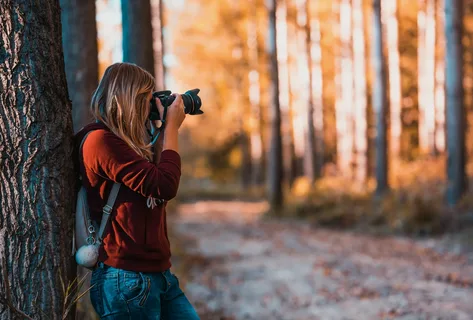Everyone enjoys watching and admiring beautiful sunsets. It’s nice to be able to capture the last rays of the sun and the delightful landscape flooded with golden light. Working with lots of different compositions and experimenting with camera settings and techniques helps you understand what works and what doesn’t. In this article, we want to share with you the best tips from professionals. This genre of photography requires additional equipment, so we recommend checking out the article about the best camera tripods on Skylum’s blog.
Table of Contents
Use a wide-angle lens
When shooting sunsets and landscapes in general, photographers usually try to capture wide-open spaces. A focal length of up to 24mm is a good starting point for getting a composed shot that captures everything you need. Shooting with a wide angle will also allow you to accentuate the sun’s glare, giving a more dramatic effect.
After the shot is taken, try adjusting the lens and using the zoom. Play around with different focal lengths, isolating certain areas. Try capturing the silhouette of a tree or other object against the sun. The only limitation should be your imagination. There are no specific rules about focal lengths, so don’t be afraid to experiment and enjoy the process.
Make sure the lens is clean
When going out in nature, you can’t avoid contaminating your equipment. Probably nothing attracts dirt like the front of a lens. Point a dirty lens into the light and the tiniest bits of dust will show themselves, ruining the shot. Of course, such spots can be removed during post-processing, but a quick wipe-down before shooting saves a lot of time later.
Although it has nothing to do with settings, a clean lens is an important initial step, especially when shooting a sunset. Bring extra items with you to help clean the lens quickly. A microfiber cloth or special wipes won’t take up much room in your bag but will be very useful.
Take photos in RAW format
There are a few instances when it’s best to use JPEG, but for shooting sunsets and landscapes in general, it makes more sense to shoot in RAW format. The only exception is when you don’t need to edit your shots on your computer.Â
However, for many photographers, post-processing or editing shots is half the fun. It also brings out more of the creative aspects of the photos taken. Shooting in RAW file format preserves all the data and gives me more flexibility in editing. This can be a very important factor, especially when shooting a frame with such a high dynamic range.
By the way, we recommend trying the modern Luminar Neo photo editor from the Skylum developer. It contains a huge set of professional AI tools and allows you to perform the most complex tasks in just a couple of clicks (if you compare it to Photoshop or Lightroom).
Aperture Priority mode
This point can be controversial, but let’s start by saying that you don’t have to work in manual mode to be a professional photographer. That doesn’t mean you should forget about it or that shooting with it won’t improve your understanding of exposure principles and camera settings. However, Aperture Priority is a good starting point and is great for shooting sunsets.
In most cameras, the Aperture Priority mode is set by rotating the dial. It depends on the specific model, but the principle is always the same. You just need to set the aperture value and the camera will find the shutter speed and ISO value. The aperture does not change until you do it yourself. This is important because it’s what determines which part of the frame will be in focus, and it also helps to achieve the effect of shining sunlight.
Low ISO
Lower values of the ISO scale usually reduce the amount of noise, so the picture looks cleaner. Set to the lowest value available, 100 or 200 usually works fine. Try to choose lower values if possible. Note that more noise at high ISO scales and automatic modes appears due to the camera responding by reducing the shutter speed or aperture size. Increasing the value itself only intensifies the incoming signal.
Watch the shutter speed
After getting the aperture and ISO right, you need to pay attention to the last tip of the exposure triangle: shutter speed. If you shoot in Aperture Priority mode, the shutter speed will be set automatically. However, you still need to make sure it doesn’t get too slow. You may need to reduce the shutter speed to avoid blurring foreground movement and camera shake when shooting handheld.
Use a tripod
You’ve probably taken many successful handheld sunset shots. However, there are some good reasons to get in the habit of bringing a tripod with you:
- It makes the shooting process slower, and that’s not always a bad thing. When using a tripod, the focus is primarily on getting a competent composition. When the first goal is accomplished, you can focus on getting the exposure right.Â
- This can be very helpful when shooting in unusual lighting conditions. After you’ve taken the picture, change your position. Try a different perspective. Raise or lower the camera. You will end up with more unique shots, rather than dozens of shots that look almost the same.
- Another reason to get a tripod is that as the sun hides behind the horizon, the light intensity decreases. This means that you may need to set a very long shutter speed where you can’t work handheld.
https://images.pexels.com/photos/157776/girl-water-dawn-summer-157776.jpeg
With the camera mounted on a tripod, you can set shutter speeds longer without fear of getting a shaky shot. However, be aware of moving objects, such as trees moving in the wind. Slow shutter speeds can lead to unwanted blurring. If you want to see a list of the best camera tripods, go to the website of the developer Skylum.
